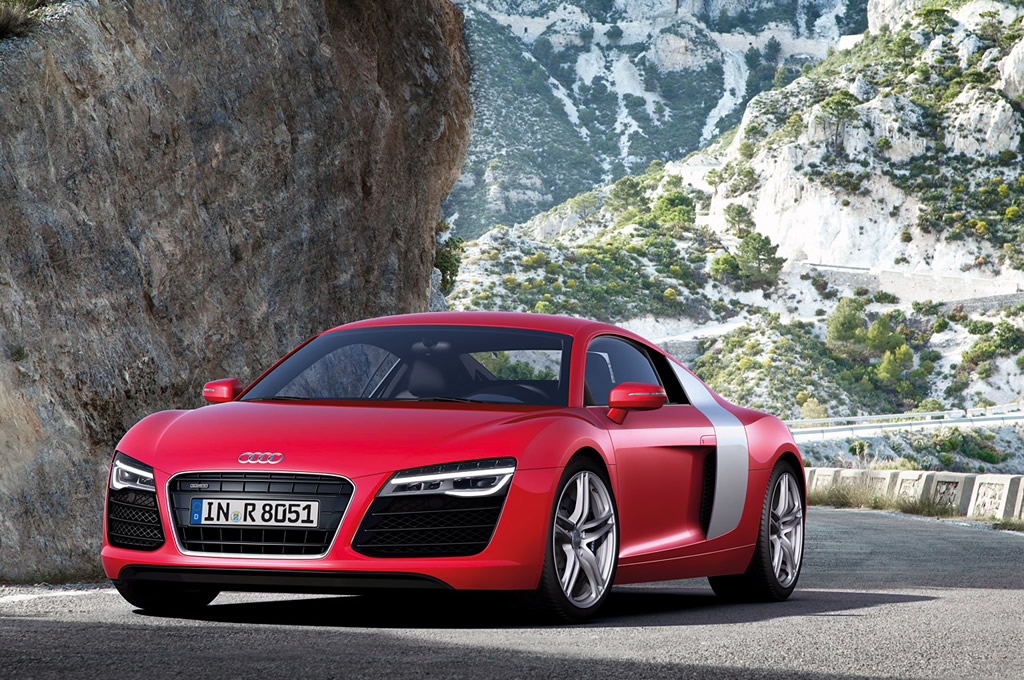2013 model of R8, Audi’s flagship two seat sports car first launched seven years ago, was completely revamped with redesigned LED headlights and taillights that come standard on all models. The biggest change to the 2013 R8 is the seven-speed S-tronic transmission that utilizes two multi-plate clutches.
The engines are assembled by hand. The V8 with 4,163 cc displacement and the V10 with its 5,204 cc displacement are captivating, naturally aspirated heavy-duty engines packed with power. The interplay with the new 7-speed S tronic has reduced CO2 emissions by up to 22 grams/km (35.41 g/mile) and decreased the sprint from zero to 100 km/h (62.14 mph) by three-tenths of a second. Both engines are compact and comparatively lightweight.
The 4.2 FSI engine produces 316 kW (430 hp) at 7,900 rpm, with a torque of 430 Nm (317.15 lb-ft) between 4,500 and 6,000 rpm. The unit accelerates the R8 Coupe with S tronic from rest to 100 km/h (62.14 mph) in 4.3 seconds and to a top speed of 300 km/h (186.41 mph) (with manual transmission: 4.6 seconds and 302 km/h (187.65 mph)). For the R8 V8 Spyder the corresponding values are 4.5 and 4.8 seconds, respectively, and also 300 km/h (186.41 mph). On average the R8 V8 quattro as a coupe with S tronic consumes 12.4 liters of fuel per 100 km (18.97 US mpg).
The R8 embodies Audi’s full expertise in ultra-lightweight design. The aluminum body with the Audi Space Frame (ASF) weighs only 210 kilograms (462.97 lb) on the Coupe, and 216 kilograms (476.20 lb) on the Spyder. The unladen R8 V8 Coupe with manual transmission registers just 1,560 kilograms (3439.21 lb) on the scales, while the open-top sports car weighs 1,660 kilograms (3659.67 lb). The R8 V10 plus, available only as a coupe, brings the needle to 1,570 kilograms (3461.26 lb). Adjustable bucket seats with glass fiber reinforced plastic (GFRP) chassis, less use of insulating materials, special light alloy wheels and chassis components, including the standard ceramic brakes, as well the CFRP add-on parts at the body all contribute to lowering the weight.
The Audi R8 V10 Coupe with S tronic accelerates from zero to 100 km/h (62.14 mph) in 3.6 seconds and reaches a top speed of 314 km/h (195.11 mph). With manual transmission the values are 3.9 seconds and 316 km/h (196.35 mph). The R8 V10 Spyder with S tronic completes the standard sprint in 3.8 seconds and has a top speed of 311 km/h (193.25 mph) (with manual transmission: 4.1 seconds and 313 km/h (194.49 mph)). The average consumption rate of the R8 V10 Coupe with S tronic lies at 13.1 liters of fuel per 100 km (17.96 US mpg).
The new top model of the model series is the Audi R8 V10 plus. Developing 404 kW (550 hp), its maximum torque is 540 Nm (398.28 lb-ft) at 6,500 rpm. With S tronic, the R8 V10 plus, available only as a coupe, catapults from zero to 100 km/h (62.14 mph) in 3.5 seconds and achieves a top speed of 317 km/h (196.97 mph); the average fuel consumption rate is 12.9 liters per 100 km (18.23 US mpg). The key data with manual transmission are 3.8 seconds, 319 km/h (198.22 mph) and 14.9 liters (15.79 US mpg).
The R8 V10 and the R8 V10 plus come with the navigation system plus and the Bang & Olufsen Sound System as standard on-board features. Other options for all R8 variants include a high-beam assistant, a stowage package, various travel case sets, a cell phone preparation, with belt microphone and voice control, and the parking system plus with reversing camera.
The overhauled Audi R8 will roll off the line to European customers at the end of the year. The base price is EUR 113,500 for the V8 Coupe, and EUR 124,800 for the Spyder. The V10 variants are listed at EUR 154,600 and EUR 165,900 respectively, while the R8 V10 plus costs EUR 173,200.


